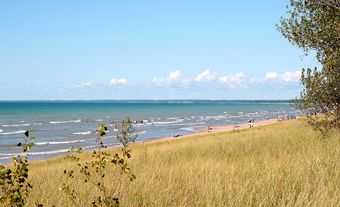Cambridge, Ontario, incorporated as a city in 1973, population 138,479 (2021 census), 129,920 (2016 census). Cambridge is located within Waterloo Region and along the Grand River. It was created through the amalgamation of the City of Galt, the Towns of Preston and Hespeler, and parts of North Dumfries and Waterloo townships.
Throughout history, the Cambridge area has been home to different Indigenous groups, namely the Neutral, Haudenosaunee and Anishinaabe. The land is covered by the Haldimand Proclamation.
Indigenous Peoples
The earliest archaeological evidence of Indigenous people in Ontario dates to between 10,500 and 9,500 years ago. Part of Cambridge was built on the site of at least one Neutral village, occupied between 1280 and 1340 CE. The village was revealed in 1987–88 during excavation for a subdivision on Myers Road in the city’s south end. At the time of European contact, in the early 1600s, Neutral villages such as this one were scattered between the Grand and Niagara rivers at the western end of Lake Ontario. In the 1650s, the Haudenosaunee, who at the time lived in what is now northern New York State, dispersed the Neutral, many of whom were absorbed by the Haudenosaunee. In the late 1600s, the Anishinaabe (a cultural group that includes the Mississauga) moved from land north of Lakes Huron and Superior into Southern Ontario, pushing most of the Haudenosaunee back to New York State. As of the 2016 census, Indigenous peoples make up about 2 per cent of Cambridge’s population.
Haldimand Proclamation
The Haudenosaunee (also known as Six Nations) allied with the British during the American Revolutionary War. After the conflict, they were displaced from their traditional territory in upstate New York and needed a new home. Mohawk leader Joseph Brant (Thayendanegea) and other representatives of the Six Nations Confederacy pressured the Crown for a land grant. Thayendanegea selected the Grand River valley, and Sir Frederick Haldimand, then governor of the Province of Quebec, agreed. In 1784, Haldimand purchased land from the Mississauga and, in the Haldimand Proclamation, granted the Haudenosaunee a tract of land 6 miles (about 10 km) deep on either side of the Grand River, from Lake Erie to the river’s head.
Thayendanegea believed that selling or leasing portions of the Haldimand tract to white settlers would be economically advantageous for the Haudenosaunee. In 1796, Thayendanegea sold 350,000 acres to the colonial government, which was parcelled into six blocks in 1798. Cambridge is in Block No. 1.

Settlement and Development
In the early 1800s, German-speaking Mennonites from Pennsylvania settled around what would become the Towns of Hespeler and Preston. The area around Galt was sold primarily to Scottish settlers.
Many milling businesses set up along the Grand and Speed rivers. One on the Speed River was named Cambridge Mills. The area around it adopted that name, until a land survey in 1834 renamed it Preston, after the surveyor’s English hometown. Preston was incorporated as a town in 1900.
Settlers chose Galt’s townsite in 1816, at the location where Mill Creek joins the Grand River. Originally named Shade’s Mills, Galt was incorporated as a town in 1857, and as a city in 1915. In 1825, it was named for John Galt, the founder of nearby Guelph, Ontario.
Hespeler was incorporated as a village in 1859, and a town in 1901. It was named for Jacob Hespeler, who built a large industrial complex on the Speed River, including flour, grist and saw mills, a cooperage to make barrels, and a distillery.
As time went on, more industrial businesses arrived. These included the Preston Car Company (1908–1922), which made streetcars for cities like Toronto and Hamilton. Galt’s industrial output earned it the nickname “The Manchester of Canada,” a reference to the British birthplace of the Industrial Revolution.
In the 1960s and 1970s, the Ontario government looked to reduce the number of small municipalities in the province. On 1 January 1973, the City of Galt, the Towns of Preston and Hespeler, and parts of the Townships of North Dumfries and Waterloo were merged to create the City of Cambridge. The name was chosen by residents in a vote, as a reference to Cambridge Mills. Waterloo Region was created at the same time.
Population
The population of Cambridge grew 6.6 per cent between 2016 and 2021, the two most recent census years, as compared to 2.5 per cent between the census years of 2011 and 2016. In the 2016 census, 30.1 per cent of Cambridge residents cited Canadian as their ethnicity, followed by English (26.9 per cent of residents), Scottish (19.9 per cent), Irish (18.7 per cent), German (13.8 per cent), Portuguese (9.5 per cent), French (9.2 per cent) and South Asian (6.2 per cent). Common countries of origin for immigrants living in Cambridge include Portugal, the United Kingdom, India, Pakistan and the Philippines.
Economy and Labour Force
A location on the Speed River in Preston has operated as a mill site since 1807. Now used by the P&H Milling Group, the facility is considered the oldest place of continuing business in Waterloo Region.
Edward Snyder was a potato farmer near Hespeler, on Beaverdale Road (now at Cambridge’s northern end). In 1935, he began selling potato chips in paper bags at local stores. After Snyder’s Potato Chips was sold in 1955, it was renamed Hostess Food Products. The factory has been on Bishop Street North since 1959, and is now Frito-Lay Canada.
As of March 2022, Toyota Motor Manufacturing Canada employs 6,000 at its two Cambridge plants. Founded in Kitchener, Dare Foods’ headquarters and main plant are in Cambridge. Various companies supply parts to the aerospace industry, including airplane landing gears and technology used on satellites.
Government and Politics
Cambridge has a mayor, eight city councillors, and two regional councillors. The city government handles matters such as roads, parks and recreation, and the fire department. The Waterloo regional government oversees transit, water, public health, and social services.

Cultural Life
Preston, Galt, and Hespeler each have historic downtowns. The modern commercial hub of the city is located between the three, along Hespeler Road.
Through adaptive reuse, one historic mill (Dickson Mill) is now a restaurant, and another is the University of Waterloo School of Architecture. Other attractions include a farmer’s market founded in 1830, an 1858 labourer’s house (McDougall Cottage Historic Site), an 1898 fire hall operating as a museum, a live theatre built in 2013, the African Lion Safari and the Cambridge Butterfly Conservatory.
Hespeler’s Fashion History Museum exhibits a portion of its over 10,000 artifacts, largely from the 19th and 20th centuries. A campus of Conestoga College is at the border with Kitchener.
The Preston Rivulettes women’s ice hockey team won ten Ontario and four Canadian championships between 1931 and 1940. Parks Canada recognized the team’s success as a National Historic Event, citing their 95 per cent win record. Galt Arena Gardens is considered the oldest continuously operating hockey arena in the world, having opened in 1922.

 Share on Facebook
Share on Facebook Share on X
Share on X Share by Email
Share by Email Share on Google Classroom
Share on Google Classroom



